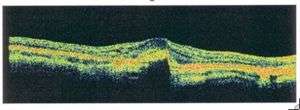Fuchs spot
The Fuchs spot, is a degeneration of the macula in case of high myopia. It is named after the two persons who first described it: Ernst Fuchs, who described a pigmented lesion in 1901, and Forster, who described subretinal neovascularisation in 1862.[1] The size of the spots are proportionate to the severity of the pathological myopia.
| Fuchs spot | |
|---|---|
| Other names | Gokul-Fuchs' retinal spot |
 | |
| An Optical coherence tomography (OCT) of the retina, showing a Fuchs spot | |
Symptoms
First signs of a Fuchs spot are distorted sight of straight lines near the fovea, which some days later turn to the typical well-circumscribed patches after absorption of haemorrhage, and a pigmented scar remains. As in macular degeneration, central sight is affected. Atrophy leads to the loss of two or more lines of the Snellen chart.
Treatment
See also
References
- "Forster-Fuchs' Retinal Spot". patient.info. Retrieved 24 December 2012.
This article is issued from
Wikipedia.
The text is licensed under Creative
Commons - Attribution - Sharealike.
Additional terms may apply for the media files.